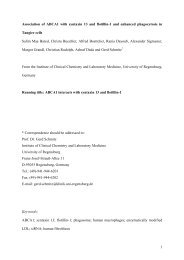SUNDAY, DECEMBER 4- Late Abstracts 1 - Molecular Biology of the ...
SUNDAY, DECEMBER 4- Late Abstracts 1 - Molecular Biology of the ...
SUNDAY, DECEMBER 4- Late Abstracts 1 - Molecular Biology of the ...
You also want an ePaper? Increase the reach of your titles
YUMPU automatically turns print PDFs into web optimized ePapers that Google loves.
<strong>SUNDAY</strong><br />
<strong>the</strong> retina, in which AII amacrine cells make <strong>the</strong>ir gap junctions. Antibodies to PSD95 did not<br />
label <strong>the</strong> inner synaptic layer, but did label <strong>the</strong> outer synaptic layer, where photoreceptor<br />
synapses are located. In <strong>the</strong> inner synaptic layer, approximately 50% <strong>of</strong> <strong>the</strong> Cx36 gap junctions<br />
were co-localized with ei<strong>the</strong>r SAP97 or SAP102, and 15% co-localized with both. SAP102 colocalized<br />
with about twice as many Cx36 gap junctions as did SAP97. Fur<strong>the</strong>rmore, <strong>of</strong> <strong>the</strong><br />
SAP102 puncta in <strong>the</strong> inner synaptic layer, fully one third were associated with Cx36 gap<br />
junctions. In <strong>the</strong> outer synaptic layer, some PSD95 immunoreactivity was closely associated<br />
with Cx36. Our data show that synaptic scaffolding proteins are associated not only with<br />
conventional synapses, but also with electrical synapses. These scaffolding proteins may<br />
facilitate assembly <strong>of</strong> non-synaptic neurotransmitter receptors, such as <strong>the</strong> NMDA receptors on<br />
AII amacrine cells, with Cx36 gap junctions. They may alternatively, or in addition, facilitate <strong>the</strong><br />
association <strong>of</strong> conventional synapses and gap junctions to form mixed synapses.<br />
2040<br />
A structural biology approach to predict proteolytic sites <strong>of</strong> accessory gland proteins in<br />
D. Melanogaster.<br />
C. A. Del Carpio 1 , M-T. Yamamoto 1 ; 1 Drosophila Genetic Resource Center (DGRC), Kyoto<br />
Institute <strong>of</strong> Technology, Kyoto, Japan<br />
Extra and intra-cellular protein processing and degradation accounts for one <strong>of</strong> <strong>the</strong> main<br />
biochemical processes involved in series <strong>of</strong> signal transduction and regulation pathways.<br />
Moreover, genome-wide studies <strong>of</strong> higher organisms have unveiled that a large proportion <strong>of</strong><br />
encoded proteins are enzymes oriented to <strong>the</strong> cleavage <strong>of</strong> o<strong>the</strong>r proteins. Thus predicting <strong>the</strong><br />
cleavage sites <strong>of</strong> substrate proteins and <strong>the</strong> enzyme involved is highly required in functional<br />
genome analyses including <strong>the</strong> elucidation <strong>of</strong> intra and extra-cellular mechanisms at <strong>the</strong> origin<br />
<strong>of</strong> cellular malfunction and diseases. Sequence based inference <strong>of</strong> proteolytic cleavage sites in<br />
polypeptides frequently leads to several sites that are located in <strong>the</strong> core <strong>of</strong> <strong>the</strong> molecule or are<br />
sterically hindered and hardly accessible to <strong>the</strong> cleaving enzyme. Catering to <strong>the</strong> need <strong>of</strong><br />
including 3D structural factors in <strong>the</strong> assessment <strong>of</strong> cleavage sites in polypeptides and reduce<br />
<strong>the</strong> number <strong>of</strong> candidates output at <strong>the</strong> primary structure level, we propose a bio-computational<br />
strategy to firstly evaluate substrate-enzyme affinity and subsequently infer putative scissible<br />
bonds. Affinity is evaluated by docking <strong>the</strong> 3D structures <strong>of</strong> <strong>the</strong> substrate and <strong>the</strong> enzyme, and<br />
molecular dynamics (MD) simulation is performed to assess <strong>the</strong> formation <strong>of</strong> <strong>the</strong> transition state<br />
(TS) complex triggering <strong>the</strong> proteolytic reaction. The cleavage sites are <strong>the</strong>n inferred by tracing<br />
<strong>the</strong> main atomic interactions throughout <strong>the</strong> MD simulation leading to formation <strong>of</strong> <strong>the</strong> TS<br />
species. The methodology involves protein structure prediction, as well as protein docking to<br />
assess substrate-enzyme interaction. As a case study we applied <strong>the</strong> methodology to <strong>the</strong><br />
prediction <strong>of</strong> cleavage sites for Acp36DE, a D. Melanogaster seminal fluid protein that plays an<br />
important role in sperm storage and competition in multiply mated females. The results show<br />
that among several candidate regions amenable to protease attack, <strong>the</strong> region LEU514-<br />
ASP517, located at a disordered region between two alpha helices shows geometrical<br />
complementarity and energetic affinity for an astacin like protease. The TS species derived<br />
through <strong>the</strong> MD simulation shows <strong>the</strong> metal (Zn) in <strong>the</strong> astacin pulling <strong>the</strong> LYS515.O, and <strong>the</strong><br />
contraction <strong>of</strong> <strong>the</strong> distance between <strong>the</strong> SER516.N and GLU101.OE2 in astacin suggests <strong>the</strong><br />
scissible peptide bond. Repeating <strong>the</strong> calculations with serine proteases reported to be<br />
expressed at copulation shows a higher affinity region for <strong>the</strong> hydrophobic region that includes<br />
amino acids SER21-GLU22-SER23-PHE24 <strong>the</strong> cleavage bond being GLU22-SER23. Cleavage<br />
<strong>of</strong> Acp36DE at LYS515-SER516 generates fragments <strong>of</strong> Acp36DE <strong>of</strong> molecular weights that<br />
compare well with reported experimental findings
















